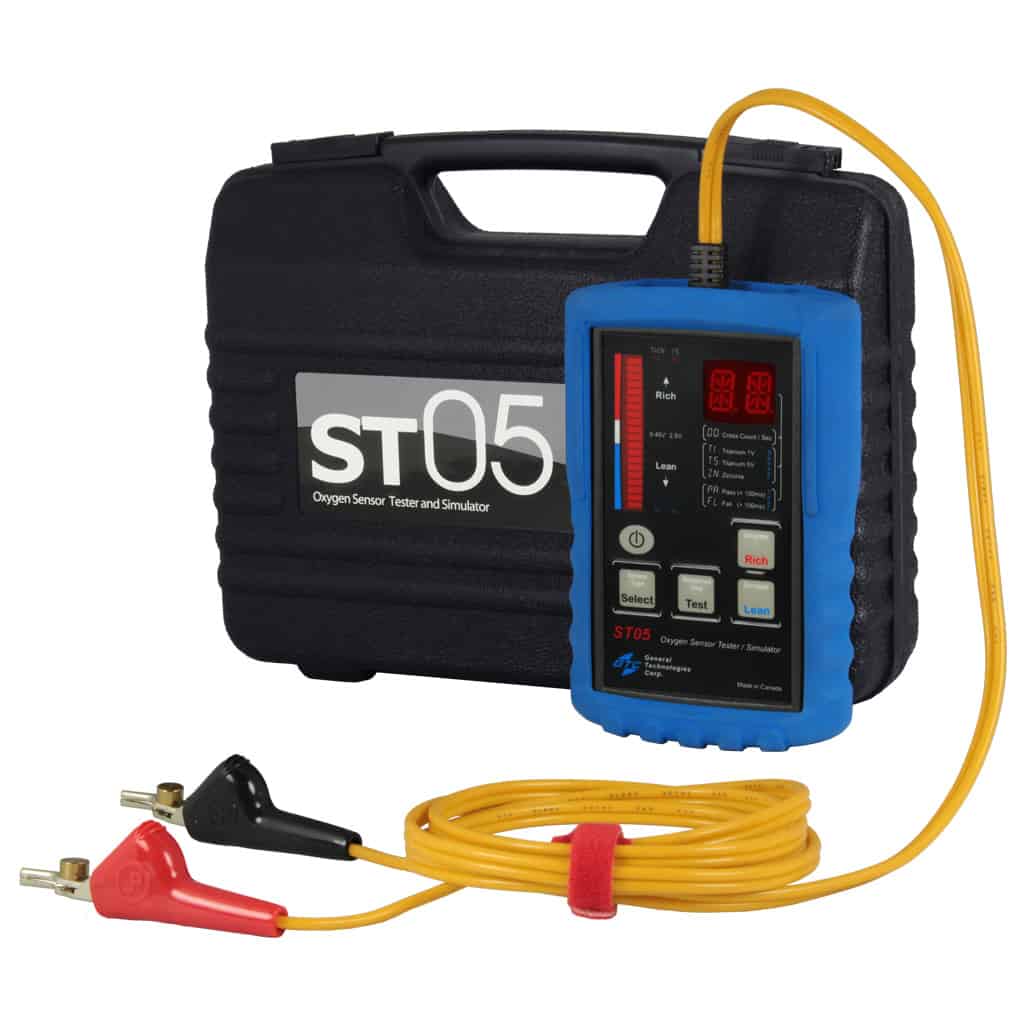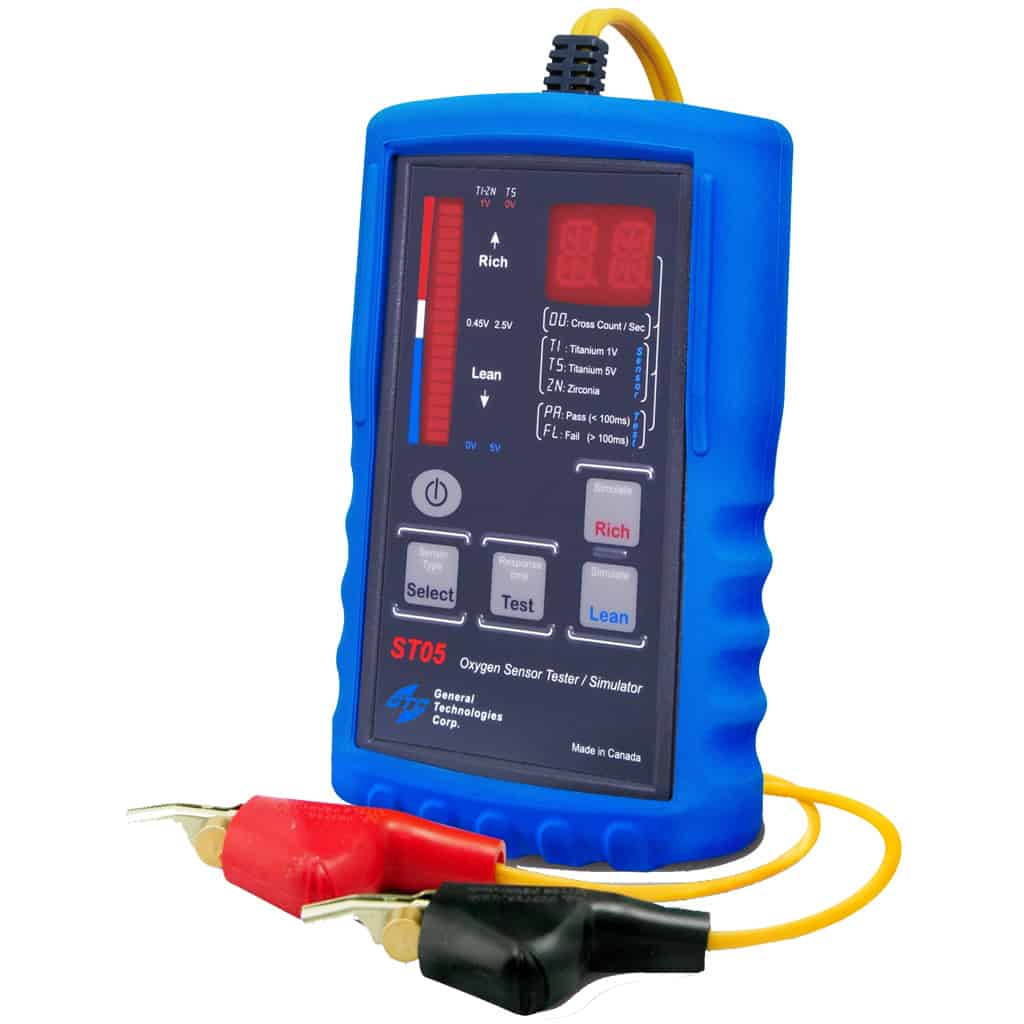ST05 Oxygen Sensor Tester and Simulator
- EASY TO INTERPRET: The sensor signal output is shown in real time on the bar graph, while a 2 digit alphanumeric display shows the sensor output cross count per second.
- QUICK DIAGNOSIS: Quickly determine whether the sensor is defective and needs replacement – press the test button and see results within seconds.
- DURABLE: Soft anti-slip rubber holster protects the instrument against impacts.
- 1-YEAR WARRANTY
Quick Links
Description
The ST05 Oxygen Sensor Tester and Simulator is an easy-to-use tool for testing and diagnosing problems with any oxygen sensor (also known as lambda sensors). This tool can help you quickly determine whether the sensor is defective and needs replacement. The ST05 is compatible with all types of oxygen sensors: Zirconia, Titania 1 volt, Titania 5 volt, wide band “dual-cell”, and heated or unheated (1, 2, 3, 4 or 5 wires).
The ST05 is designed as a stand-alone tool which can also complement scan tools in the diagnostic process. The tool provides the means for fast and accurate testing, showing the sensor’s output signal in real time in a bar graph, which allows to diagnose “lazy” sensors which may not trigger DTC’s but cause drivability problems. It also display cross counts on an alphanumeric display, and can simulate rich and lean conditions. Sensors can be tested ON or OFF vehicle, and the ST05 does not require time-consuming setups or in-depth knowledge.
Applications
- Test zirconia sensors
- Test titania 1 Volt sensors
- Test titania 5 Volt sensors
- Test 1 to 4 wire sensors (heated and unheated)
- Simulate rich and lean sensor output
- Test sensor response time
Specifications
- Display:
- 2 digits LED alphanumeric display
- 20 segments LED bargraph with 0 to 1 Volt or 0 to 5 Volt ranges
- Cross Count: 0.1 to 10 CPS/
- Response test: <100 ms Pass +/- 5 ms, >100 ms Fail +/- 5 ms
- Test leads: 2 wire piercing alligator clips, and 6.5 ft cables
- Power Source: One standard 9 Volt alkaline battery type NEDA 1604 IEC 6F 22
- Battery life: Approx. 25 hrs, with low battery indicator and auto power
FAQ
ST05: identifying the type of oxygen sensor
There is no easy way to identify an oxygen sensor type by simply looking at it; however, there are a few guidelines you can follow to make the process easier:
- 1- 95 % of the Oxygen sensors on the market are the Zirconium type.
- 2- Titanium 1 V sensors (are made to) behave like Zirconium type. The easiest way to identify them is by measuring the signal circuit, because unlike the Zirconium type sensors, in order to work they need to be supplied with power (1 Volt) by the ECM or PCM.
- 3- Titanium 5 V are rare, and were mainly used in off-road vehicles in the late 80s and early 90’s. The easiest way to identify them is by measuring the signal circuit, because unlike the Zirconium type sensors, in order to work they need to be supplied with power (5 Volt) by the ECM or PCM.
- 4- Zirconium and Titanium sensors may have 1, 2, 3 or 4 wire connections, while wide band (fuel/Air ratio) sensors have 5 or more connecting wires.
The ST05 is designed to work with all types of sensors, and will not get damaged when connected to any type of oxygen sensor (including the heater wires) even if the wrong type of sensor is selected, nor will it damage the sensor it is connected to.
ST05: use on air fuel sensors
The ST05 can be used for checking wideband or air/fuel ratio sensors. Below is an extract of the ST05 User’s Manual where it describes how to use the ST05 with this type of sensor:
4.1.4 Wide Band (Air/Fuel Ratio) dual cell sensors:
- These sensors, with the Bosch LSU4 being the most popular one, use two Zirconia cells, one is used as a conventional Zirconium sensor (reference or Nerst cell), and the second is used to ‘pump’ oxygen into the reference cell in order to keep it at or near the stoichiometric output. The PCM measures how much oxygen (current) it needs to pump into the reference cell to keep it at a set output ( approximately 0.45 Volts), and from this calculates the actual mixture in the exhaust. A basic test can be performed on this type of sensor by simply measuring the output signal of the reference (Nerst) cell, and observing that a good sensor should output a signal level which is steady and near stoichiometric (0.45 Volts).
Documents
Download Brochure (English)
Download Manual (English)
Kit Manifest
- ST05 (core unit)
- 1604A (9-volt alkaline) battery
- Two piercing clips with 6 ft. cables
- Protective rubber holster
- Polypropylene carrying case
- User’s Manual
Proposition 65 Warning ⚠
This product can expose you to chemicals including Styrene, which is known to the State of California to cause cancer, and Bisphenol A (BPA), which is known to the State of California to cause birth defects or other reproductive harm. For more information go to: www.P65Warnings.ca.gov.



